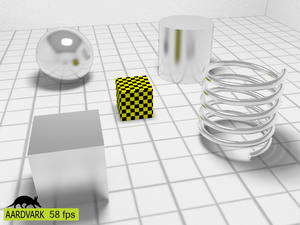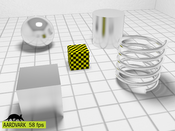Information
- Publication Type: Master Thesis
- Workgroup(s)/Project(s):
- Date: November 2012
- TU Wien Library:
- First Supervisor:
Abstract
Interactive walkthroughs of virtual scenes are not only common in fictional settings such as entertainment and video games, but also a popular way of presenting novel architecture, furnishings or illumination. Due to the high performance requirements of such interactive applications, the presentable detail and quality are limited by the computational hardware. A realistic appearance of materials is one of the most crucial aspects to scene immersion during walkthroughs, and computing it at interactive frame rates is a challenging task.In this thesis an algorithm is presented that achieves the rendering of static scenes featuring view-dependent materials in real-time. For walkthroughs of static scenes, all light propagation but the last view-dependent bounce can be precomputed and stored as diffuse irradiance light maps together with the scene geometry. The specular part of reflection and transmission is then computed dynamically by integrating the incident light approximatively according to view and local material properties. For this purpose, the incident radiance distribution of each object is approximated by a single static environment map that is obtained by rendering the light-mapped scene as seen from the object. For large planar reflectors, a mirror rendering is performed every frame to approximate the incident light distribution instead of a static environment map. Materials are represented using a parametric model that is particularly suitable for fitting to measured reflectance data. Fitting the parameters of a compact model to material measurements provides a straightforward approach of reproducing light interactions of real-world substances on a screen.
During walkthroughs, the view-dependent part of the local illumination integral is approximated by sampling the representation of incident light while weighting the samples according to the material properties. Noise-free rendering is achieved by reusing the exact same sampling pattern at all pixels of a shaded object, and by filtering the samples using MIP-maps of the incident light representation. All available samples are regularly placed within the specular lobe to achieve a uniform symmetric coverage of the most important part of the integration domain even when using very few (5-20) samples. Thus, the proposed algorithm achieves a biased but stable and convincing material appearance at real-time frame rates. It is faster than existing random-based sampling algorithms, as fewer samples suffice to achieve a smooth and uniform coverage of specular lobes.
Additional Files and Images
Weblinks
No further information available.BibTeX
@mastersthesis{Muehlbacher_2012_RRM,
title = "Real-Time Rendering of Measured Materials",
author = "Thomas M\"{u}hlbacher",
year = "2012",
abstract = "Interactive walkthroughs of virtual scenes are not only
common in fictional settings such as entertainment and video
games, but also a popular way of presenting novel
architecture, furnishings or illumination. Due to the high
performance requirements of such interactive applications,
the presentable detail and quality are limited by the
computational hardware. A realistic appearance of materials
is one of the most crucial aspects to scene immersion during
walkthroughs, and computing it at interactive frame rates is
a challenging task. In this thesis an algorithm is
presented that achieves the rendering of static scenes
featuring view-dependent materials in real-time. For
walkthroughs of static scenes, all light propagation but the
last view-dependent bounce can be precomputed and stored as
diffuse irradiance light maps together with the scene
geometry. The specular part of reflection and transmission
is then computed dynamically by integrating the incident
light approximatively according to view and local material
properties. For this purpose, the incident radiance
distribution of each object is approximated by a single
static environment map that is obtained by rendering the
light-mapped scene as seen from the object. For large planar
reflectors, a mirror rendering is performed every frame to
approximate the incident light distribution instead of a
static environment map. Materials are represented using a
parametric model that is particularly suitable for fitting
to measured reflectance data. Fitting the parameters of a
compact model to material measurements provides a
straightforward approach of reproducing light interactions
of real-world substances on a screen. During walkthroughs,
the view-dependent part of the local illumination integral
is approximated by sampling the representation of incident
light while weighting the samples according to the material
properties. Noise-free rendering is achieved by reusing the
exact same sampling pattern at all pixels of a shaded
object, and by filtering the samples using MIP-maps of the
incident light representation. All available samples are
regularly placed within the specular lobe to achieve a
uniform symmetric coverage of the most important part of the
integration domain even when using very few (5-20) samples.
Thus, the proposed algorithm achieves a biased but stable
and convincing material appearance at real-time frame rates.
It is faster than existing random-based sampling algorithms,
as fewer samples suffice to achieve a smooth and uniform
coverage of specular lobes.",
month = nov,
address = "Favoritenstrasse 9-11/E193-02, A-1040 Vienna, Austria",
school = "Institute of Computer Graphics and Algorithms, Vienna
University of Technology ",
URL = "https://www.cg.tuwien.ac.at/research/publications/2012/Muehlbacher_2012_RRM/",
}

 Poster
Poster Thesis
Thesis


